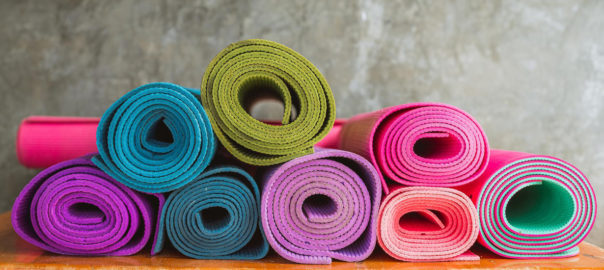Choose the best yoga mat for your budget
What is the purpose of a yoga mat?
A yoga mat defines the space where you practice during a yoga session. It symbolizes the time and space that you reserve for yourself to meditate on your body and mind and their mutual relationship through yoga exercises.
- What you experience on the mat is often very similar to what you experience in real life, outside the yoga mat.
- What you learn on the mat you can take with you into your life outside the mat to put into practice.
And from a purely practical point of view, the yoga mat provides a suitable and solid base or substrate. This allows you to perform your yoga exercises in safety and comfort.
Quality criteria for yoga mats
A good yoga mat is:
- resistant to slip:even when standing wide-legged, you stand firmly and your feet do not slip.
- resistant to wear: even with frequent use the surface of the mat remains in good condition. If occasionally you ever get a toenail or fingernail caught in the mat the latter will remain virtually intact.
- easy to wash and maintain:after each use, wipe the mat clean with a damp cloth soaked in water and some disinfectant essential oil. Allow the mat to dry before rolling it up. Some lighter mats can, according to the manufacturer, also be cleaned in the washing machine.
A yoga mat should ideally also be:
- long lasting: it is better to pay a little more for a mat that will last for years than to buy a cheap mat that will break down after only a few months and will need to be replaced.
- Produced as environmentally friendly as possible. Look for a yoga mat that is made with as little fuss as possible in natural, recyclable materials. Or in synthetic materials with as few harmful components as possible. Watch out for “greenwashing”: some of the so-called eco-mats are not wear-resistant at all and need to be replaced rather quickly.
- produced as locally as possible: for us Europeans this means that they should come from a European factory rather than being shipped from the other side of the planet.
The most suitable size
The standard size of a yoga mat is 60 cm x 180 cm. If you are much taller than 1 m 80, you can buy longer yoga mats from many brands at an additional cost. They will be better adapted to your height and can measure up to 200 cm long.
There are also so-called double size mats, which are rather square (approx. 180 cm x 180 cm).
And there are also round yoga mats with a diameter of about 200 cm.
How thick should a yoga mat be?
On a good yoga mat you should be able to stand firmly and sit comfortably.
The ideal thickness for a studio mat is 5 to 6 mm.
Mats of about 4 mm are lighter to transport.
There are also so-called travel mats that are only about 3 mm thick.
Note: the thicker, resilient silicon like mats (1.5 cm to 2 cm thick) are intended for fitness or Pilates, but are not suitable for yoga. You will not stand firmly enough on them.
What are current price categories?
The best entry level mat
Are you starting with yoga and not sure if you’re going to do it in the long run? Buy a good, non-slip basic mat of about 4 to 5 mm thick in the price range of 17.00 to 25.00 euros. Look online at websites such as yogamatters.com.
Is there a better mid level mat?
In the price range between 35.00 euros and 45.00 euros, you have to be careful. There are many overpriced models in this category. Despite their great promises, do not really live up to the expectations. So for the extra money, you don’t always get concrete extra value. Be especially wary of so-called ecological mats that have a surface that is far too fragile. For instance, they quickly deteriorate under the influence of sunlight. It is best to only buy mats that you have actually been able to hold in your hands to check their structure.
Top of the range and best buy
The best yoga mats are 5 to 6 mm thick, sturdy and virtually indestructible. We ourselves have been using the Black Pro yoga mats of the brand Manduka with a thickness of 6 mm in our studio for almost 10 years. These mats are used in many professional yoga studios. Although this brand has American origins, it is common knowledge that only 1 manufacturer in Germany produces these mats. These mats are quite heavy, but can even withstand the claws of cats. They potentially last for decades. These mats are now also available in many other colours and thicknesses.
For a mat of this level of quality, you should pay around 85.00 to 100.00 euros.
Summary
If you want to buy a yoga mat, I recommend you not to save on quality and durability. Cheap yoga mats often wear out very quickly and need to be replaced.
The most important feature of a good yoga mat is that it should be absolutely non-slip. You need to find optimum and effortless stability during standing poses.
An acceptable yoga mat starts at about 20.00 euros each. In my opinion, the best yoga mats are those from Manduka, they cost around 85.00 euros to 100.00 euros each. That may seem a lot at first sight, but such a mat will last a lifetime. In between you have a wide choice. More and more manufacturers claim to produce their mats in a sustainable way, although these can sometimes turn out be empty promises.

